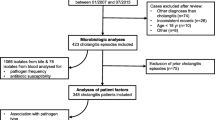Abstract
Background
Bile cultures are often sent with blood cultures in patients with acute bacterial cholangitis.
Aims
To assess the yield of blood and bile cultures in patients with cholangitis and the clinical utility of bile cultures in guiding therapy.
Methods
All patients diagnosed with cholangitis, based on the Tokyo 2013/2018 guidelines were recruited retrospectively over ten years. The clinical and investigation details were recorded. The results of bile and blood cultures including antibiotic sensitivity patterns were noted. The concordance of microorganisms grown in blood and bile cultures and their sensitivity pattern were assessed.
Results
A total of 1063 patients with cholangitis were included. Their mean age was 52.7 ± 14 years and 65.4% were males. Blood cultures were positive in 372 (35%) patients. Bile culture was performed in 384 patients with 84.4% being positive, which was significantly higher than the yield of blood culture (p < 0.001). Polymicrobial growth was more in bile (59.3%) than in blood cultures (13.5%, p < 0.001). E.coli, Klebsiella, Enterococcus and Pseudomonas were the four most common organisms isolated from both blood and bile. Extended spectrum betalactamase producing organisms were isolated in 57.7% and 58.8% of positive blood and bile cultures, respectively. Among 127 patients with both blood and bile cultures positive, complete or partial concordance of organisms was noted in about 90%.
Conclusion
Bile and blood cultures have a similar microbial profile in most patients with cholangitis. As bile cultures have a significantly higher yield than blood cultures, they could effectively guide antimicrobial therapy, especially in those with negative blood cultures.
Graphical Abstract



Similar content being viewed by others
References
Dw L, Sc C. Vol. 11, Bailliere’s clinical gastroenterology. Baillieres Clin Gastroenterol; 1997 [cited 2020 Oct 15]. Biliary infection. Available from: https://pubmed.ncbi.nlm.nih.gov/9512806/
Agarwal N, Sharma BC, Sarin SK. Endoscopic management of acute cholangitis in elderly patients. World J Gastroenterol WJG. 2006;12:6551–6555.
Lai EC, Mok FP, Tan ES et al. Endoscopic biliary drainage for severe acute cholangitis. N Engl J Med. 1992;326:1582–1586.
Lee JG. Diagnosis and management of acute cholangitis. Nat Rev Gastroenterol Hepatol. 2009;6:533–541.
Rerknimitr R, Fogel EL, Kalayci C, Esber E, Lehman GA, Sherman S. Microbiology of bile in patients with cholangitis or cholestasis with and without plastic biliary endoprosthesis. Gastrointest Endosc. 2002;56:885–889.
Sahu MK, Chacko A, Dutta AK, Prakash JAJ. Microbial profile and antibiotic sensitivity pattern in acute bacterial cholangitis. Indian J Gastroenterol. 2011;30:204–208.
Negm AA, Schott A, Vonberg RP et al. Routine bile collection for microbiological analysis during cholangiography and its impact on the management of cholangitis. Gastrointest Endosc. 2010;72:284–291.
Gomi H, Solomkin JS, Schlossberg D et al. Tokyo Guidelines 2018: antimicrobial therapy for acute cholangitis and cholecystitis. J Hepato-Biliary-Pancreat Sci. 2018;25:3–16.
Buxbaum JL, Buitrago C, Lee A et al. ASGE guideline on the management of cholangitis. Gastrointest Endosc. 2021;94:207-221.e14.
Kiriyama S, Kozaka K, Takada T et al. Tokyo Guidelines 2018: diagnostic criteria and severity grading of acute cholangitis (with videos). J Hepato-Biliary-Pancreat Sci. 2018;25:17–30.
Rupp C, Bode K, Weiss KH et al. Microbiological Assessment of Bile and Corresponding Antibiotic Treatment: A Strobe-Compliant Observational Study of 1401 Endoscopic Retrograde Cholangiographies. Medicine (Baltimore). 2016;95:e2390.
Park JW, Lee JK, Lee KT, Lee KH, Sung YK, Kang CI. How to interpret the bile culture results of patients with biliary tract infections. Clin Res Hepatol Gastroenterol. 2014;38:300–309.
Chandra S, Klair JS, Soota K, Livorsi DJ, Johlin FC. Endoscopic Retrograde Cholangio-Pancreatography-Obtained Bile Culture Can Guide Antibiotic Therapy in Acute Cholangitis. Dig Dis Basel Switz. 2019;37155–60.
Gromski MA, Gutta A, Lehman GA et al. Microbiology of bile aspirates obtained at ERCP in patients with suspected acute cholangitis. Endoscopy. 2022;54:1045–1052.
Shenoy SM, Shenoy S, Gopal S, Tantry BV, Baliga S, Jain A. Clinicomicrobiological analysis of patients with cholangitis. Indian J Med Microbiol. 2014;32:157–160.
Kawamura S, Karasawa Y, Toda N et al. Impact of the Sensitivity to Empiric Antibiotics on Clinical Outcomes after Biliary Drainage for Acute Cholangitis. Gut Liver. 2020;14:842–849.
Mazuski JE, Tessier JM, May AK et al. The Surgical Infection Society Revised Guidelines on the Management of Intra-Abdominal Infection. Surg Infect. 2017;18:1–76.
Kruis T, Güse-Jaschuck S, Siegmund B, Adam T, Epple HJ. Use of microbiological and patient data for choice of empirical antibiotic therapy in acute cholangitis. BMC Gastroenterol. 2020;20:65.
Raghhupatruni P, Gopalakrishna R, Ankarath V, Sadasivan S. Profile and Outcome of Patients with Acute Cholangitis in a Tertiary Center in South India. J Dig Endosc. 2021;12:127–132.
Funding
The author(s) received no financial support for the research, authorship, and/or publication of this article.
Author information
Authors and Affiliations
Contributions
JTG, AKD and RJ were involved in planning the study. JTG, AT, AJ and RJ were involved in data extraction. Statistical analysis was done by JTG and JSPG. JTG, JSPG, RJ, AJ, AKD AT, RTK, SDC, EGS and AJJ were involved in drafting the manuscript. Critical revision of the manuscript was performed by AKD, EGS, RTK, RJ, SDC and AJJ.
Corresponding author
Ethics declarations
Conflict of interest
There were no conflicts of interest.
Additional information
Publisher's Note
Springer Nature remains neutral with regard to jurisdictional claims in published maps and institutional affiliations.
Rights and permissions
Springer Nature or its licensor (e.g. a society or other partner) holds exclusive rights to this article under a publishing agreement with the author(s) or other rightsholder(s); author self-archiving of the accepted manuscript version of this article is solely governed by the terms of such publishing agreement and applicable law.
About this article
Cite this article
George, J.T., Thomas, A., Jaleel, R. et al. Bile Culture May Guide Antibiotic Stewardship in Acute Bacterial Cholangitis. Dig Dis Sci (2024). https://doi.org/10.1007/s10620-024-08289-w
Received:
Accepted:
Published:
DOI: https://doi.org/10.1007/s10620-024-08289-w




